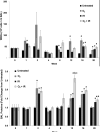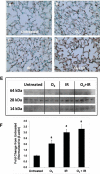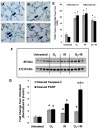Oxidative Lung Damage Resulting from Repeated Exposure to Radiation and Hyperoxia Associated with Space Exploration
- PMID: 24358450
- PMCID: PMC3866035
Oxidative Lung Damage Resulting from Repeated Exposure to Radiation and Hyperoxia Associated with Space Exploration
Abstract
Background: Spaceflight missions may require crewmembers to conduct Extravehicular Activities (EVA) for repair, maintenance or scientific purposes. Pre-breathe protocols in preparation for an EVA entail 100% hyperoxia exposure that may last for a few hours (5-8 hours), and may be repeated 2-3 times weekly. Each EVA is associated with additional challenges such as low levels of total body cosmic/galactic radiation exposure that may present a threat to crewmember health and therefore, pose a threat to the success of the mission. We have developed a murine model of combined, hyperoxia and radiation exposure (double-hit) in the context of evaluating countermeasures to oxidative lung damage associated with space flight. In the current study, our objective was to characterize the early and chronic effects of repeated single and double-hit challenge on lung tissue using a novel murine model of repeated exposure to low-level total body radiation and hyperoxia. This is the first study of its kind evaluating lung damage relevant to space exploration in a rodent model.
Methods: Mouse cohorts (n=5-15/group) were exposed to repeated: a) normoxia; b) >95% O2 (O2); c) 0.25Gy single fraction gamma radiation (IR); or d) a combination of O2 and IR (O2+IR) given 3 times per week for 4 weeks. Lungs were evaluated for oxidative damage, active TGFβ1 levels, cell apoptosis, inflammation, injury, and fibrosis at 1, 2, 4, 8, 12, 16, and 20 weeks post-initiation of exposure.
Results: Mouse cohorts exposed to all challenge conditions displayed decreased bodyweight compared to untreated controls at 4 and 8 weeks post-challenge initiation. Chronic oxidative lung damage to lipids (malondialdehyde levels), DNA (TUNEL, cleaved Caspase 3, cleaved PARP positivity) leading to apoptotic cell death and to proteins (nitrotyrosine levels) was elevated all treatment groups. Importantly, significant systemic oxidative stress was also noted at the late phase in mouse plasma, BAL fluid, and urine. Importantly, however, late oxidative damage across all parameters that we measured was significantly higher than controls in all cohorts but was exacerbated by the combined exposure to O2 and IR. Additionally, impaired levels of arterial blood oxygenation were noted in all exposure cohorts. Significant but transient elevation of lung tissue fibrosis (p<0.05), determined by lung hydroxyproline content, was detected as early as 2 week in mice exposed to challenge conditions and persisted for 4-8 weeks only. Interestingly, active TGFβ1 levels in +BAL fluid was also transiently elevated during the exposure time only (1-4 weeks). Inflammation and lung edema/lung injury was also significantly elevated in all groups at both early and late time points, especially the double-hit group.
Conclusion: We have characterized significant, early and chronic lung changes consistent with oxidative tissue damage in our murine model of repeated radiation and hyperoxia exposure relevant to space travel. Lung tissue changes, detectable several months after the original exposure, include significant oxidative lung damage (lipid peroxidation, DNA damage and protein nitrosative stress) and increased pulmonary fibrosis. These findings, along with increased oxidative stress in diverse body fluids and the observed decreases in blood oxygenation levels in all challenge conditions (whether single or in combination), lead us to conclude that in our model of repeated exposure to oxidative stressors, chronic tissue changes are detected that persist even months after the exposure to the stressor has ended. This data will provide useful information in the design of countermeasures to tissue oxidative damage associated with space exploration.
Keywords: Apoptosis; Bronchoalveolar lavage; Caspase 3; Double-hit; Extravehicular activity; Hyperoxia; Inflammation; Lung fibrosis; Lung injury; Mouse model; Nitrotyrosine; Oxidative stress; PARP; Radiation pneumonopathy; Space exploration; TGF-β1; TUNEL; Total body irradiation.
Figures










Similar articles
-
Flaxseed Mitigates Acute Oxidative Lung Damage in a Mouse Model of Repeated Radiation and Hyperoxia Exposure Associated with Space Exploration.J Pulm Respir Med. 2014;4(6):1000215. doi: 10.4172/2161-105X.1000215. J Pulm Respir Med. 2014. PMID: 25705570 Free PMC article.
-
Novel Double-Hit Model of Radiation and Hyperoxia-Induced Oxidative Cell Damage Relevant to Space Travel.Int J Mol Sci. 2016 Jun 16;17(6):953. doi: 10.3390/ijms17060953. Int J Mol Sci. 2016. PMID: 27322243 Free PMC article.
-
Radiation mitigating properties of the lignan component in flaxseed.BMC Cancer. 2013 Apr 4;13:179. doi: 10.1186/1471-2407-13-179. BMC Cancer. 2013. PMID: 23557217 Free PMC article.
-
Immune System Dysregulation During Spaceflight: Potential Countermeasures for Deep Space Exploration Missions.Front Immunol. 2018 Jun 28;9:1437. doi: 10.3389/fimmu.2018.01437. eCollection 2018. Front Immunol. 2018. PMID: 30018614 Free PMC article. Review.
-
Ionizing radiation-induced risks to the central nervous system and countermeasures in cellular and rodent models.Int J Radiat Biol. 2021;97(sup1):S132-S150. doi: 10.1080/09553002.2020.1820598. Epub 2020 Oct 20. Int J Radiat Biol. 2021. PMID: 32946305 Review.
Cited by
-
Synthetic Secoisolariciresinol Diglucoside (LGM2605) Protects Human Lung in an Ex Vivo Model of Proton Radiation Damage.Int J Mol Sci. 2017 Nov 25;18(12):2525. doi: 10.3390/ijms18122525. Int J Mol Sci. 2017. PMID: 29186841 Free PMC article.
-
Space radiation-associated lung injury in a murine model.Am J Physiol Lung Cell Mol Physiol. 2015 Mar 1;308(5):L416-28. doi: 10.1152/ajplung.00260.2014. Epub 2014 Dec 19. Am J Physiol Lung Cell Mol Physiol. 2015. PMID: 25526737 Free PMC article.
-
Changes in apoptotic microRNA and mRNA expression profiling in Caenorhabditis elegans during the Shenzhou-8 mission.J Radiat Res. 2015 Nov;56(6):872-82. doi: 10.1093/jrr/rrv050. Epub 2015 Aug 17. J Radiat Res. 2015. PMID: 26286471 Free PMC article.
-
Radiation-induced lung injury and inflammation in mice: role of inducible nitric oxide synthase and surfactant protein D.Toxicol Sci. 2015 Mar;144(1):27-38. doi: 10.1093/toxsci/kfu255. Epub 2014 Dec 30. Toxicol Sci. 2015. PMID: 25552309 Free PMC article.
-
Role of Cytochrome P450 (CYP)1A in Hyperoxic Lung Injury: Analysis of the Transcriptome and Proteome.Sci Rep. 2017 Apr 4;7(1):642. doi: 10.1038/s41598-017-00516-x. Sci Rep. 2017. PMID: 28377578 Free PMC article.
References
-
- Holloway RJ, Leong GF, Ainsworth EJ, Albright ML, Baum SJ. Recovery from radiation injury in the hamster as evaluated by the split-dose technique. USNRDL-TR-1111. Res Dev Tech Rep. 1967 - PubMed
-
- Hu S, Kim MH, McClellan GE, Cucinotta FA. Modeling the acute health effects of astronauts from exposure to large solar particle events. Health Phys. 2009;96:465–476. - PubMed
-
- Leong GF, Page NP, Ainsworth EJ, Hanks GE. Injury accumulation in sheep during protracted gamma radiation. USNRDL-TR-998. Res Dev Tech Rep . 1966 - PubMed
-
- Townsend LW. Implications of the space radiation environment for human exploration in deep space. Radiat Prot Dosimetry. 2005;115:44–50. - PubMed
-
- Prisk GK. The lung in space. Clin Chest Med. 2005;26:415–438. vi. - PubMed
Grants and funding
LinkOut - more resources
Full Text Sources
Research Materials
